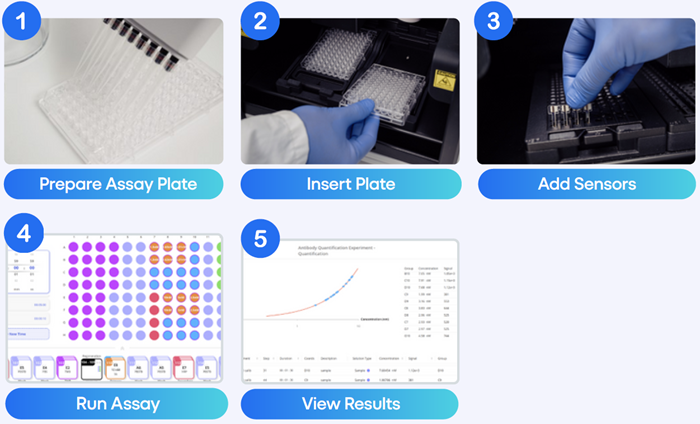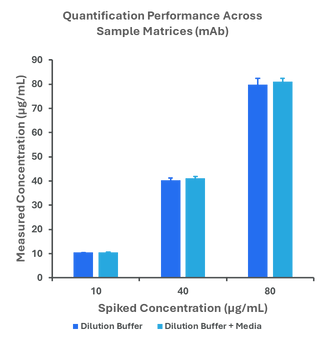The Amperia™ benchtop instrument measures proteins and viral vectors quickly and accurately, even from complicated samples.
This benchtop device has no optical or fluidic components, ensuring consistent findings across users, test formats, and sample types.
Amperia™, powered by Redox Electrochemical Detection (RED), is easy to set up with its guided touchscreen interface, resulting in quicker decisions in research and development.
The science behind Amperia
Amperia™ relies on patented Redox Electrochemical Detection (RED) technology to monitor electrical signals produced by enzyme-substrate reactions at the sensor tip. This signal indicates the amount of the bound analyte, allowing quantitative readouts without the use of optics or fluidics.
RED is reliable even in turbid, colored, or unpurified materials, making it suitable for crude lysates, viral vectors, and complicated matrices.
Amperia™ provides consistent and clear results without requiring optical alignment or fluid handling.

Redox Electrochemical Detection (RED) principle. RED measures enzyme-driven electron transfer at the sensor surface. HRP-labeled detection reagents catalyze TMB redox cycling, and the resulting electron transfer produces a current proportional to the amount of target bound. This enables quantitative detection without requiring optics or active fluidics. Image Credit: Abselion
What can users measure with Amperia™?
Amperia™ enables quick measurement of a variety of biologics, including monoclonal antibodies, viral vectors, and tagged proteins. The platform supports both pure and complex samples, offering several throughput options with less hands-on time.
Amperia™ is evolving to address the demands of current biologics processes by targeting broader molecular targets and expanding use cases.
Source: Abselion
| Target |
Example Use |
Throughput
(per run) |
Run Time
(min) |
Hands-on Time
(min/per run) |
Detection Range |
Antibodies
(e.g., mAbs) |
Clone screening
and culture profiling |
Up to 64 |
~ 75-200 |
~ 15-30 |
μg/mL‑scale |
| AAV capsids |
Serotype analysis
and process tracking |
Up to 40 |
~ 120 |
~ 15-30 |
0.78e9 - 1e11 vp/mL |
Tagged Proteins
(e.g. His-tag) |
Expression monitoring
and lysate analysis |
Up to 40 |
~ 65 |
~ 20-30 |
nM‑scale |
Note: Values shown are typical ranges based on internal testing. Actual throughput and hands-on time may vary depending on assay format, sample type, and workflow configuration. The detection range may vary depending on the analyte affinity and assay conditions.
Assay format compatibility
Amperia™ supports three assay formats, each suitable for different interactions between the analyte and detection reagents. They all use dip-style sensors with functionalized capture surfaces, but the introduction of the detecting component differs.
- When the analyte prevents detection binding, the signal diminishes in Inverse Occupancy.
- The sandwich format uses sequential capture and detection to provide a direct signal.
- In Premix Competition, analytes and detection analogues fight for the same site, resulting in an inverse signal. This adaptability enables accurate measurement of diverse biologic targets.

Assay formats supported on the Amperia platform. Each format uses dip-style sensors with a capture surface but differs in binding order and signal behavior: (1) Inverse Occupancy; (2) Sandwich; (3) Premix Competition. Image Credit: Abselion
Each assay format is tailored to individual target types, ensuring consistent signal behavior and assay performance. Antibodies are quantified using Inverse Occupancy, viral vectors using Sandwich, and tagged proteins by Premix Competition.
This assay design guarantees consistent results across applications and expands target coverage.
Source: Abselion
| Format |
Used For |
Signal Type |
| Inverse Occupancy |
Antibody quantification (e.g., mAbs) |
Inversely proportional |
| Sandwich |
AAV capsids |
Directly proportional |
| Premix Competition |
Tagged proteins (e.g., His-tag) |
Inversely proportional |
Running an Amperia assay
Amperia™'s touchscreen-guided procedure ensures consistent results across all assay formats, making it easy to use at the bench.
The 5-step approach, from plate preparation to data output, ensures reliable findings without requiring specialized apparatus. Built-in analytical tools simplify the workflow and create consistent, actionable data.

Touchscreen-Guided 5-Step Workflow on the Amperia™ Platform: From plate setup to final data export, Amperia guides users through a consistent, step-by-step process - no external software or specialist training required. The built-in interface streamlines assay setup, run execution, and result analysis across all supported formats. Image Credit: Abselion
- Fast: Designed for speed, from sample to results.
- Reliable: Ensures reliable performance, even for complicated samples.
- Accessible: Designed for easy use without requiring an expert.
Data highlights



Representative bar charts generated using Amperia. Demonstrating consistent quantification across targets and matrices. Image Credit: Abselion
Amperia™ provides consistent, quantifiable performance for major biologic targets, including monoclonal antibodies, AAV capsids, and tagged proteins.
These examples demonstrate Amperia™'s versatility across various sample types and workflows, showing strong standard curves in both buffer and sophisticated media formats.
Instrument specifications
The Amperia™ system is compact and bench-ready, combining sensor-based detection, onboard control, and user-friendly software into a single platform. The table below sets out the essential technical parameters for planning and deployment in lab environments:
Source: Abselion
| Specification |
Details |
| Dimensions (W × D × H) |
Approx. 35 × 33 × 26 cm |
| Weight |
~ 18 kg |
| Sample types |
Crude lysate, purified protein |
| Temperature control |
15 - 40 °C |
| Agitation function |
500 - 1000 rpm |
| Interface |
Built-in touchscreen |
| Connectivity |
USB, Wi-Fi |
| Data export format |
.csv, .xlsx, PDF |
| Software features |
Built-in analysis, guided setup |
| Power supply |
100 - 240 V AC |
Note: Cooling to 15 °C or 5 °C below ambient, whichever is higher.